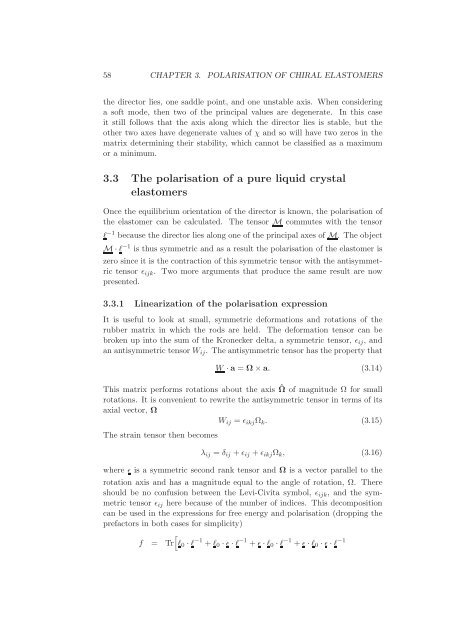Statistical models of elasticity in main chain and smectic liquid ...
Statistical models of elasticity in main chain and smectic liquid ...
Statistical models of elasticity in main chain and smectic liquid ...
You also want an ePaper? Increase the reach of your titles
YUMPU automatically turns print PDFs into web optimized ePapers that Google loves.
58 CHAPTER 3. POLARISATION OF CHIRAL ELASTOMERSthe director lies, one saddle po<strong>in</strong>t, <strong>and</strong> one unstable axis. When consider<strong>in</strong>ga s<strong>of</strong>t mode, then two <strong>of</strong> the pr<strong>in</strong>cipal values are degenerate. In this caseit still follows that the axis along which the director lies is stable, but theother two axes have degenerate values <strong>of</strong> χ <strong>and</strong> so will have two zeros <strong>in</strong> thematrix determ<strong>in</strong><strong>in</strong>g their stability, which cannot be classified as a maximumor a m<strong>in</strong>imum.3.3 The polarisation <strong>of</strong> a pure <strong>liquid</strong> crystalelastomersOnce the equilibrium orientation <strong>of</strong> the director is known, the polarisation <strong>of</strong>the elastomer can be calculated. The tensor M commutes with the tensorl −1 because the director lies along one <strong>of</strong> the pr<strong>in</strong>cipal axes <strong>of</strong> M. The objectM·l −1 is thus symmetric <strong>and</strong> as a result the polarisation <strong>of</strong> the elastomer iszero s<strong>in</strong>ce it is the contraction <strong>of</strong> this symmetric tensor with the antisymmetrictensor ǫ ijk . Two more arguments that produce the same result are nowpresented.3.3.1 L<strong>in</strong>earization <strong>of</strong> the polarisation expressionIt is useful to look at small, symmetric deformations <strong>and</strong> rotations <strong>of</strong> therubber matrix <strong>in</strong> which the rods are held. The deformation tensor can bebroken up <strong>in</strong>to the sum <strong>of</strong> the Kronecker delta, a symmetric tensor, ǫ ij , <strong>and</strong>an antisymmetric tensor W ij . Theantisymmetric tensor has the property thatW ·a = Ω×a. (3.14)This matrix performs rotations about the axis ˆΩ <strong>of</strong> magnitude Ω for smallrotations. It is convenient to rewrite the antisymmetric tensor <strong>in</strong> terms <strong>of</strong> itsaxial vector, ΩW ij = ǫ ikj Ω k . (3.15)The stra<strong>in</strong> tensor then becomesλ ij = δ ij +ǫ ij +ǫ ikj Ω k , (3.16)where ǫ is a symmetric second rank tensor <strong>and</strong> Ω is a vector parallel to therotation axis <strong>and</strong> has a magnitude equal to the angle <strong>of</strong> rotation, Ω. Thereshould be no confusion between the Levi-Civita symbol, ǫ ijk , <strong>and</strong> the symmetrictensor ǫ ij here because <strong>of</strong> the number <strong>of</strong> <strong>in</strong>dices. This decompositioncan be used <strong>in</strong> the expressions for free energy <strong>and</strong> polarisation (dropp<strong>in</strong>g theprefactors <strong>in</strong> both cases for simplicity)[f = Tr l 0 ·l −1 +l 0 ·ǫ·l −1 +ǫ·l 0 ·l −1 +ǫ·l 0 ·ǫ·l −1
















